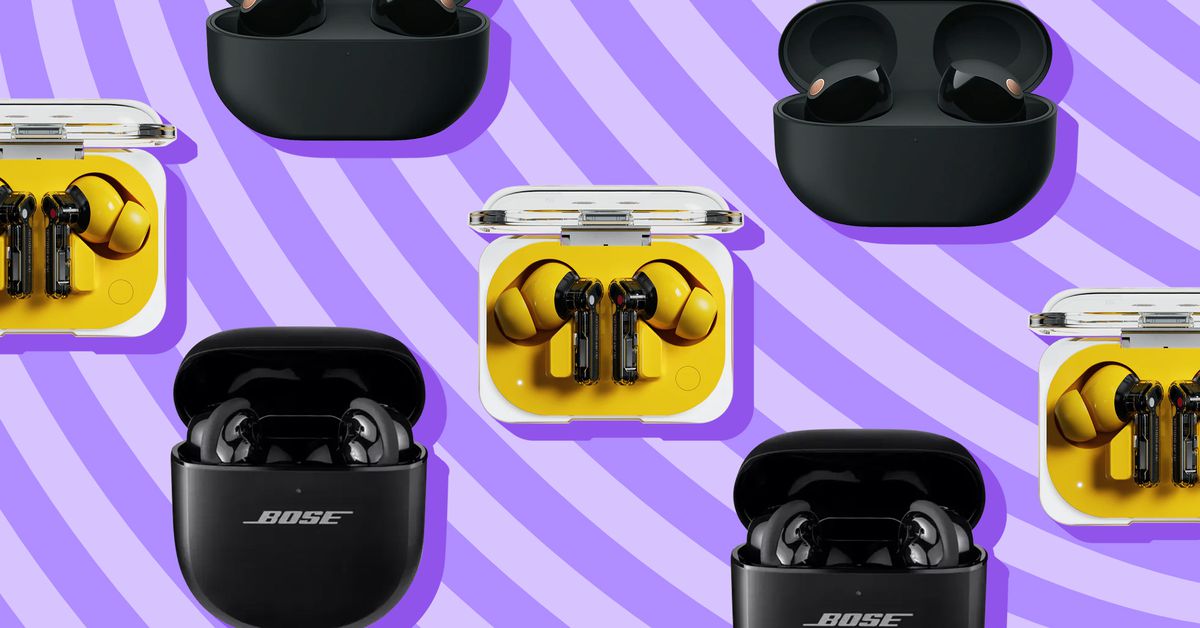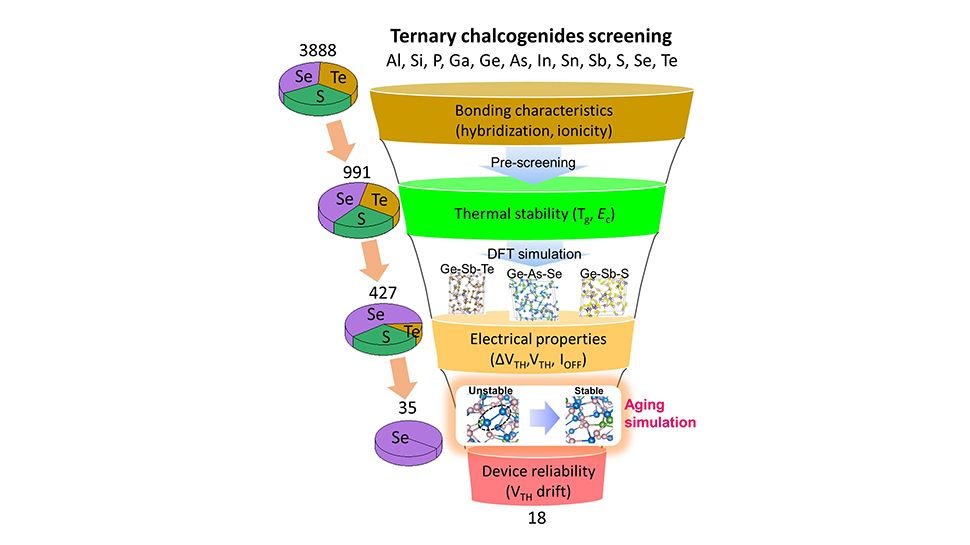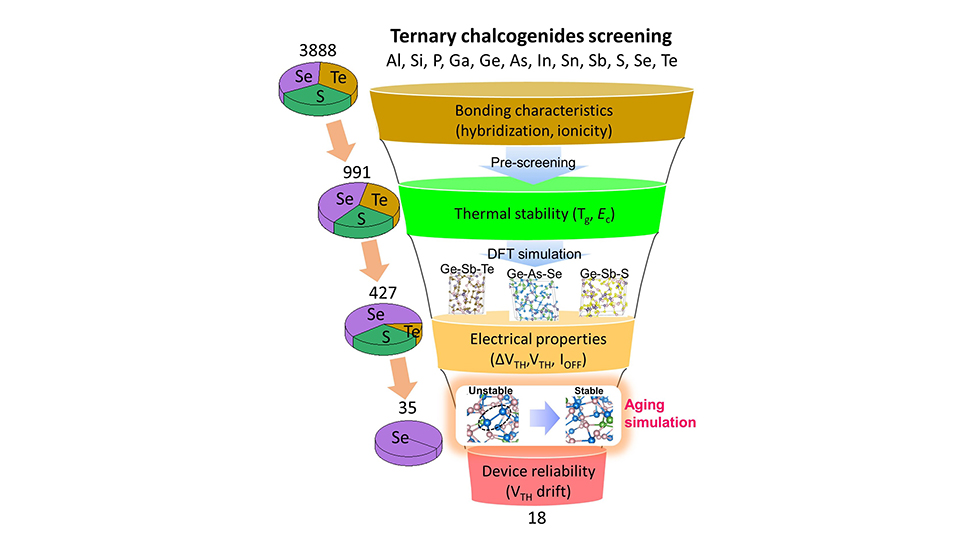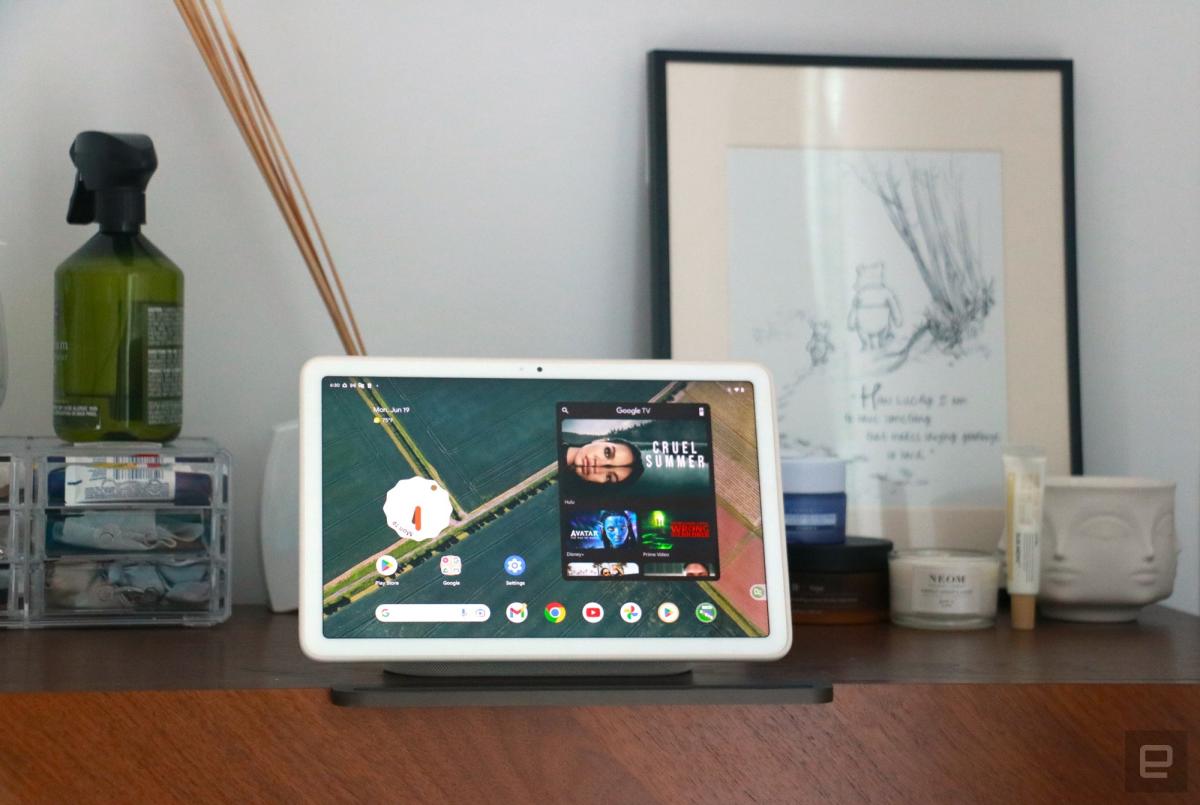It’s hard to buy a bad pair of wireless earbuds these days, and with constant discounts and deals wherever you look, now is as good of a time as any to splurge on the pair you’ve been eyeing. The market has come a long way since the early era of true wireless earbuds when we had to deal with mediocre sound quality and unreliable performance, all for the sake of ditching cables. Things are much different now. After several product generations of learned lessons, companies like Sony, Apple, Samsung, and others are releasing their most impressive earbuds to date.
Technology
The best wireless earbuds for 2024

You can get phenomenal noise cancellation and sound quality in the premium tier of earbuds if you’re willing to spend big. But those aren’t always the most important criteria for everyone: maybe you’re looking for the perfect fitness earbuds or for a set that works just as well for Zoom calls as for playing your favorite playlists and podcasts.
Tech companies are increasingly making their earbuds work best with their own products through exclusive features and functionality, so that’s another thing to consider as you shop around. If you want a perk like head-tracking spatial audio, you’ll need to use AirPods with an iPhone, Samsung buds with a Samsung phone, and so on.
The best overall wireless earbuds
$298
Sony’s flagship WF-1000XM5 noise-canceling earbuds improve upon the previous model with richer sound quality, slightly more powerful ANC, and vastly improved comfort thanks to their reduced size and weight. Read our review.
Noise cancellation: Yes / Battery life: 8 hours (ANC on) / Water resistance: IPX4 / Bluetooth codecs: LDAC, AAC, SBC / Multipoint: Yes / Works best with: Android, iOS, Windows, macOS / Ear tips: Foam (XS, S, M, L)
Just like their predecessors, Sony’s new WF-1000XM5 earbuds have again topped our recommendations for the overall best noise-canceling earbuds. Thanks to their larger drivers, the audio quality is more detailed and dynamic than before while still retaining the warmth and clarity that made the 1000XM4 so enjoyable. Sony has also further improved its ANC and is nearing the same territory as Bose’s QC Earbuds II. These earbuds do a terrific job of eliminating background noise. Battery life can stretch to eight hours of continuous listening with noise cancellation turned on.
Some people found the WF-1000XM4 to be bulky and uncomfortable, so this time around, Sony has managed to shrink the 1000XM5 by 25 percent. Like before, the company includes foam-style tips that expand in your ears to create an excellent seal — and now there’s a fourth (extra small) set of tips in the box.
On Android phones, the 1000XM5 support Sony’s LDAC codec for higher-quality music playback. And they’re capable of dynamic head tracking spatial audio through supported video apps like Netflix. But even if you’re not using LDAC (or have an iPhone), these are up there with the very best audio-focused premium earbuds like Sennheiser’s Momentum True Wireless 4 — with substantially better noise cancellation to boot. They’re also capable of multipoint Bluetooth, so you can pair with two devices at the same time.
It’s worth noting that there were many reports of battery issues with the 1000XM4 over time as those earbuds aged, but Sony claims to have rectified that problem with the new model by tweaking the charging algorithm.
The best budget earbuds under $100
Noise cancellation: Yes / Battery life: 5.5 hours (ANC on) / Water resistance: IP54 / Bluetooth codecs: LDAC, AAC, SBC / Multipoint: No / Works best with: Android, iOS, Windows, macOS / Ear tips: Silicone (S, M, L)
When looking at Nothing’s Ear (a) earbuds, it’s easy to focus all your attention on the catchy yellow color or their fun, super compact carrying case. But at their $99.99 price, the company’s entry-level earbuds provide a ton of features, including active noise cancellation, a low-latency mode for gaming, multipoint Bluetooth pairing, and a decent IP54 dust and water resistance rating.
And the sound quality you get outperforms my usual expectations for this price point. They’re not quite on par with Nothing’s higher-end Ears, but you do get expressive, very enjoyable audio — and you can customize the EQ further in Nothing’s mobile app.
The best noise-canceling earbuds
$299
With dynamic, rich sound and the best noise cancellation available in true wireless earbuds, the Bose QuietComfort Ultra Earbuds are a terrific pick if you want to listen to your music in peace. Read our review.
Noise cancellation: Yes / Battery life: 6 hours (ANC on) / Water resistance: IPX4 / Bluetooth codecs: AAC, SBC, aptX Adaptive / Multipoint: No / Works best with: Android, iOS, Windows, macOS / Ear tips: Silicone (S, M, L)
Bose’s QuietComfort Ultra Earbuds are the most powerful noise-canceling earbuds on the market. Of all our top picks, they do the best job at offering peace and quiet from the cacophony of daily life and putting you in a private bubble with your music playlists or favorite podcasts.
The QC Ultra Earbuds are extremely similar to 2022’s QC Earbuds II in terms of design, fit, and sound. Audio quality is rich and dynamic, delivering more bass thump than, say, Apple’s AirPods Pro. And by switching to a two-piece ear tip / stabilizer fitting process, Bose’s latest flagship buds should fit a wider range of ears more comfortably. The Ultras also introduce a new Immersive Audio mode, which is Bose’s take on spatial audio.
The best earbuds for sports and working out
The Beats Fit Pro earbuds have integrated wing tips that help keep them secure during runs and workouts. They also have excellent noise cancellation, and their sound has just the right amount of bass and kick to keep you motivated. Read our review.
Noise cancellation: Yes / Battery life: 6 hours (ANC on) / Water resistance: IPX4 / Bluetooth codecs: AAC, SBC / Multipoint: No / Works best with: Android, iOS, Windows, macOS / Ear tips: Silicone (S, M, L)
The long-reigning champ of fitness earbuds, the Powerbeats Pro, have finally been defeated. And fittingly, they’ve been outdone by Beats’ most recent pair of gym-friendly earbuds. The Beats Fit Pro trade the ear hooks of the Powerbeats for a wing tip design that keeps them securely locked in your ears during even the most vigorous workouts. As a result, these earbuds have a much smaller form factor — and their carrying case is mercifully far more manageable. The way these earbuds magnetically latch into the case also means you don’t have to worry about one or both buds failing to charge in the case, which was a common annoyance with the Powerbeats Pro.
Unlike the Powerbeats Pro, the Fit Pros include active noise cancellation. And they’re on par with the previous AirPods Pro in that department, so you’ll be able to exercise without distraction. When you do want to stay alert to your surroundings, the transparency mode is also as natural-sounding and clear as on the AirPod Pros.
The earbuds are rated IPX4 for water resistance. While that’s not as robust as some other fitness-focused buds, it should be sufficient to survive sweat and outdoor runs in various conditions. The Fit Pros have easy-to-use physical button controls, and although they lack the dedicated volume rocker of the Powerbeats Pro, you’ve got the option to remap a long-press of each earbud to adjust volume instead of toggling noise cancellation.
If you’re an iPhone owner, the Fit Pros offer Apple-only features like dynamic head tracking for spatial audio, auto device switching, Find My integration, and more. For Android users, Beats has an app that will let you adjust settings and see the battery status of the earbuds and case, among other functions.
The best earbuds for iPhone owners
The second-gen AirPods Pro improve upon Apple’s original pair with much better noise cancellation, improved sound quality, and onboard volume controls. The latest refresh also ships with a USB-C charging case, as opposed to Lightning. Read our hands-on impressions.
Noise cancellation: Yes / Battery life: 6 hours (ANC on) / Water resistance: IPX4 / Bluetooth codecs: AAC, SBC / Multipoint: No / Works best with: iOS, Windows, macOS / Ear tips: Silicone (XS, S, M, L)
For those invested in Apple’s ecosystem, the second-gen AirPods Pro bring an appealing mix of top-notch noise cancellation and refined sound compared to the original pair. As always, they also include numerous features (spatial audio, audio sharing, automatic syncing across iCloud devices, etc.) that make them an ideal companion to the company’s other devices. They’re also the only AirPods that come with different sizes of ear tips for a customizable fit — including an extra small option.
The AirPods Pro have a compact case that supports wireless charging. Setting them up is as simple as holding the open case near your iPhone. The earbuds are lightweight and fit snugly in most ears. Their force sensor pinch controls are easy to get down, and with the second-gen model, Apple added swipe-based volume controls. The AirPods Pro have traditionally ranked among the best wireless earbuds when it comes to voice call quality, and the second-gen earbuds don’t disappoint. Their ANC is improved over the original model and is now right up there with Sony, and their transparency mode has gained the ability to quickly damper sudden, loud noises that might happen around you.
Where the AirPods stand out is with their Apple-only features like head tracking for spatial audio, automatic device switching, extensive Find My support, and so on. The charging case now features a built-in speaker and a U1 chip for pinpoint location tracking, and the latest AirPods Pro have better sound and noise canceling capabilities than the original model. Plus, they retain their deep integration with Apple’s hardware ecosystem.
The best earbuds for Samsung Galaxy phone owners
$250
The Galaxy Buds 3 Pro are Samsung’s best-sounding wireless earbuds yet. They have a stemmed design similar to the AirPods Pro, but even if their design is a little bland, the Buds 3 Pro make up for it with great call quality, useful voice commands, and more. Read our review.
Noise cancellation: Yes / Battery life: 6 hours (ANC on) / Water resistance: IP57 / Bluetooth codecs: Samsung seamless, AAC, SBC / Multipoint: No / Works best with: Android, Windows, macOS / Ear tips: Silicone (S, M, L)
Samsung’s Galaxy Buds 3 Pro ditch the company’s more discreet designs of the past for a stemmed style that’s similar to AirPods and any number of other wireless earbuds. Boring? Maybe, but thanks to that change, I’ve found them to be more comfortable and provide better stability than the Buds 2 Pro. The sound quality is even better than before — and it was already excellent. These are right up there with Sennheiser and Technics from an audio fidelity standpoint.
The Buds 3 Pro are also a standout performer when it comes to call quality. And my favorite thing about these earbuds are the hands-free voice commands that don’t require you to say any specific wake phrase beforehand. You can just say “volume up” and or “next song” and it happens.
But they’re not perfect: the Buds 3 Pro lack multipoint connectivity, so they can’t connect to two devices at the same time. Just like Apple, Samsung prefers to automatically hop between products within its own walled garden ecosystem. Some people might consider this a dealbreaker, but I’ve still enjoyed the earbuds plenty without it.
The best earbuds for Google Pixel phone owners
$229
Significantly smaller and lighter than their predecessors, the Pixel Buds Pro 2 also offer stronger noise cancellation, a crystal clear transparency mode, and lengthy battery life. Read our review.
Noise cancellation: Yes / Battery life: 8 hours (ANC on) / Water resistance: IP54 / Bluetooth codecs: AAC, SBC / Multipoint: Yes / Works best with: Android, Windows, macOS / Ear tips: Silicone (XS, S, M, L)
With the Pixel Buds Pro 2, Google has addressed most of the downsides of the original pair. They’re far smaller and lighter than the chunky first-gen Pixel Buds Pro. And there’s a small nub on the buds to help lock them in place even during intensive activities like running or exercise.
Google’s active noise cancellation still isn’t on the same tier as Bose, but the transparency mode on the Buds Pro 2 is among the very best you’ll find. It offers a crisp, natural passthrough for the outside world when needed. Multipoint support is included, and Google’s latest earbuds eke out impressive battery life that surpasses most competitors.
Got a Pixel phone? With the Pixel Buds Pro 2, you can have lengthy conversations with Google’s Gemini AI while your phone stays in your pocket. Features like head-tracking spatial audio and Clear Calling are also exclusive to those within the Pixel ecosystem. If that’s you, the Pixel Buds Pro 2 are a big step up from the previous buds in a much smaller package.
The best earbuds if you own both Apple and Android devices
The Beats Studio Buds Plus offer better sound and noise cancellation than the original pair, and they now come in a unique translucent color option. Read our review.
Noise cancellation: Yes / Battery life: 6 hours (ANC on) / Water resistance: IPX4 / Bluetooth codecs: AAC, SBC / Multipoint: No / Works best with: Android, iOS, Windows, macOS / Ear tips: Silicone (XS, S, M, L)
Beats’ Studio Buds Plus are an upgraded, better-performing revision of the Studio Buds released in 2021. This time the company has made the noise cancellation more powerful while also improving the quality of the transparency mode and extending battery life. If you’re going for style points, it doesn’t get much cooler than the translucent color option. These earbuds are very tiny and rank up with the best in terms of overall comfort.
What’s interesting about the Studio Buds Plus is that they use a proprietary chip that allows them to support native software features on both iOS and Android. Plenty of earbuds offer companion apps on each platform, but in the case of the Beats, they work with both Apple’s Find My and Google’s Find My Device. You also get simple one-tap pairing no matter which OS you’re using.
The drawback to this dual-ecosystem life is that Apple customers don’t get all the usual bells and whistles that come with AirPods or even the Beats Fit Pro; you lose out on audio sharing, head tracking spatial audio, and other tricks. Wireless charging and an ear detection sensor (for auto-pause when a bud is removed) are also MIA, which stings a bit considering the price.
The best earbuds for sound quality
Sennheiser’s MTW4 earbuds provide a top-notch listening experience, decent noise cancellation, and sound personalization for a custom audio profile that’s uniquely tuned to your ears. Read our review.
Noise cancellation: Yes / Battery life: 7.5 hours (ANC on) / Water resistance: IP54 / Bluetooth codecs: AptX Adaptive, AptX, AAC, SBC / Multipoint: Yes / Works best with: Android, iOS, Windows, macOS / Ear tips: Silicone (XS, S, M, L)
Sennheiser’s Momentum True Wireless earbuds have always sounded fantastic; that’s never been the issue. But previous models in the series have been tainted a bit by bugs, unsteady performance, and battery reliability problems. The fourth-gen pair finally gets that part right while continuing to offer tremendous, detailed sound quality that stands above nearly all competitors. They’re a joy to listen to. The active noise cancellation can’t compete with the likes of Apple, Sony, and Bose, but if you care more about lush, intricate sound, the MTW4 won’t disappoint in the slightest.
These earbuds come with optional wing tips to help keep them securely locked in your ears. That could prove helpful for running or when hitting the gym. Sennheiser allows for plenty of EQ customization using its mobile app, and the Momentum True Wireless 4 support a range of Bluetooth codecs, including AAC, SBC, AptX, and AptX Adaptive. Sennheiser has also promised that they’re LE Audio and Auracast-ready for when those features become more widespread.
The best earbuds for voice calls on iPhone
Noise cancellation: Optional / Battery life: 5 hours / Water resistance: IP54 / Bluetooth codecs: AAC, SBC / Multipoint: No / Works best with: iOS, Windows, macOS / Ear tips: None
Apple’s AirPods 4 come in two different versions, with a higher-priced option that includes active noise cancellation and wireless charging. But sound quality is identical on both sets, and equally as important in this case is that the same can be said of voice call clarity.
On the AirPods 4, there’s a new “voice isolation” feature — it’s enabled by default — that uses machine learning both on the earbuds and your iPhone to eliminate distracting background noise on your end so that you come through clearly to whoever you’re speaking with.
Overall call quality is excellent with the AirPods 4. And beyond that, compared to the third-gen model, you can expect upgraded audio quality (with richer bass), new ways of interacting with Siri through head movements, and yes… there’s a USB-C connector instead of Lighting.
The AirPods still have a one-size-fits-most hard plastic form factor, so I recommend trying them yourself before committing to a purchase. But Apple says it used over 50 million data points to further refine the contours and overall stability of its latest earbuds. So if previous pairs worked well for you, these seem like a safe bet. The only question is whether you feel like spending a little more to gain ANC, transparency mode, wireless charging, and a built-in speaker for Find My location tracking.
The best earbuds for voice calls on Android
Sony’s LinkBuds have a standout design that’s rooted in comfort and an airy, open sound. They also excel when used for voice calls, outshining pretty much all competitors. Read our review.
Noise cancellation: No / Battery life: 5.5 hours / Water resistance: IPX4 / Bluetooth codecs: AAC, SBC / Multipoint: Yes / Works best with: Android, iOS, Windows, macOS / Ear tips: Fitting supporters (XS, S, M, L, XL)
Sony’s unconventional-looking LinkBuds have a donut hole right in the middle of each earbud. This surprisingly comfortable design is meant to allow in outside noise and keep you aware of your surroundings at all times. But it also means that the LinkBuds won’t be for everyone — especially those people who prefer to drown out the world when listening to their music.
But more than their quirky fit, the LinkBuds’ greatest strength is stellar performance on voice calls. Sony reworked its voice isolation algorithms for these earbuds, and as a result, the LinkBuds are several rungs above nearly all competitors, minus AirPods. If you’re looking for something you can pop into your ears throughout the workday, the LinkBuds don’t disappoint.
Photography by Chris Welch / The Verge except where specified
Update, October 25th: Updated pricing / availability and added several related links.
Technology
Samsung scientists are working on a new type of memory that could bring RAM like speeds and SSD capacities together


Samsung has used advanced computer modeling to accelerate the development of Selector-Only Memory (SOM), a new memory technology that combines non-volatility with DRAM-like read/write speeds and stackability.
Building on the company’s earlier research in the field, SOM is based on cross-point memory architectures, similar to phase-change memory and resistive RAM (RRAM), where stacked arrays of electrodes are used. Typically, these architectures require a selector transistor or diode to address specific memory cells and prevent unintended electrical pathways.
Samsung has taken a novel approach by exploring chalcogenide-based materials that function as both the selector and the memory element, introducing a new form of non-volatile memory.
A broader search
eeNews Analog reports Samsung researchers will present their findings at this year’s International Electron Devices Meeting (IEDM), taking place from December 7 to 11, in San Francisco. The South Korean tech giant will discuss how it screened an extensive range of chalcogenide materials for SOM applications.
Samsung says its study explored over 4,000 material combinations, narrowing them down to 18 promising candidates using Ab-initio-based computer modeling (see the diagram at the top of the page). The focus was on improving threshold voltage drift and optimizing the memory window – two key factors in SOM performance.
Traditional SOM research has been limited to the use of Ge, As, and Se chalcogenide systems found in ovonic threshold switches (OTS). However, Samsung says its comprehensive modeling process allowed for a broader search, considering bonding characteristics, thermal stability, and device reliability to enhance performance and efficiency.
In a follow-up IEDM presentation, eeNews Analog reports, IMEC researchers will discuss potential atomic mechanisms, such as local atomic bond rearrangement and atomic segregation, that could explain how the selector component in SOM operates, further influencing threshold voltage – an important factor in memory performance.
More from TechRadar Pro
Technology
A major contributor to India’s growth story- The Week

The online gaming industry in India has been on a transformational journey with a promising growth trajectory, despite regulatory ambiguities and a high tax rate. Not only has it been a major contributor to the broader media & entertainment space but has also become an integral component of the Animation, Visual Effects, Gaming & Comics (AVGC) sector in India, drawing significant government support, with many states crafting their own AVGC policies to give a boost to the sector.
With over 1,400 homegrown online gaming companies, India’s online gaming sector is uniquely positioned to support the goals of our country’s economic growth ambitions, attract large foreign investments, generate sizeable employment, and spur innovation. Consequently, it has the potential and the necessary elements to become a global supplier and establish itself to become India’s soft power on the global front.
India hosts the second-largest community of gamers globally and has become a popular choice in the entertainment sector, which clearly reflects a transformative shift in the entertainment consumption pattern. With this being said, the online gaming industry goes beyond the premises of entertainment; it opens up opportunities in various other allied industries such as UI/UX design, data engineering, development, programming, testing, sales, branding & marketing, etc. It also fuels innovation in emerging sectors like AI/ML, cybersecurity & cloud, and fintech.
Currently, this sector alone provides over 1 lakh jobs to the skilled workforce of the country and is expected to add 1.5 lakh more by 2025. Further, with only 31% of the rural population using the internet compared to 67% of urban residents, as per the India Inequality Report 2022, there is a significant economic opportunity to increase internet access and digital inclusion in rural areas.
A recent report by the EGROW foundation and Primus Partners states that there has been a 20-fold increase in the workforce between 2018-2023, with a 97.56% compounding annual growth rate. In terms of workforce participation, the industry has significant male participation and was mostly viewed as a male-dominant industry for the longest time. But what truly stands out is the evolving gender dynamics in this space, with female workforce participation far outpacing male workforce participation, achieving a massive 103.15% CAGR in the same period.
Moreover, there has been a steady increase in female participation in gaming. As of 2022, about 43% of women engaged in online gaming daily, with most female participation from non-metro cities. Furthermore, the sector not only recognizes the contribution that women bring to the creative and business processes but also fosters a more inclusive environment for them to thrive. This is evident in the surge in female gaming content creators and streamers in the country.
The findings of the report also highlight the sector’s contribution to the AVGC industry, which is projected to rise 68% by 2026. The government has provided much-needed impetus to the industry by charting out a forward-looking path, constituting a task force, and setting up the first National Centre of Excellence solely dedicated to the AVGC industry.
However, for the industry to thrive and enter the next phase of growth, the government must come out with a national AVGC policy that has been in the works for some time.
Despite the tremendous growth seen by the industry, certain concerns pertaining to excessive screen time, addiction and financial fraud remain. This becomes even more critical in the context of teenagers and young adults who need to be made aware of responsible gaming practices. In this regard, the recent installation of ‘Beware of Smartphone Zombies’ signboards in Bengaluru is a stark reminder of the growing epidemic of digital distraction. While some of these concerns are being addressed by the industry, more can be done to safeguard vulnerable consumers. For instance, to limit exposure to screen time and mitigate financial risk for the consumer, features such as time limits, monetary limitations and exclusions have been introduced by several gaming platforms with the aid of technology.
Further online gaming platforms often require personal information such as name, age, contact details, and in case of real money gaming, also financial information. With this comes the risk of data breaches and related concerns such as identity theft leading to financial fraud. In this context, Know Your Customer (KYC) procedures play a critical role in helping protect both consumers as well as businesses from fraud. Further, online gaming intermediaries are required to process and store digital personal and non-personal data in compliance with the applicable data protection laws of India. However, until the Digital Personal Data Protection Act comes into force, this remains a voluntary effort.
Last but not the least, a sector which holds substantial economic promise deserves regulatory backing and clarity. For much of its existence, the industry has operated self-sufficiently, wherein the collective efforts of the industry have led the way for a more robust, responsible, and accountable ecosystem. However, regulatory ambiguities and uncertainties have time and again created roadblocks for Indian gaming startups, and therefore, it is necessary that regulatory clarity be provided, and as a first step, the amended IT rules be implemented.
With an encouraging regulatory environment, the online gaming industry, which has seen a 27.45% CAGR between 2019 to 2022, in its contribution towards the country’s GDP, can further enhance India’s growth story and solidify its position as a disrupter in the global gaming landscape.
(The author is a Member of Parliament, Rajya Sabha, and former Minister of State for GAD, Education, Health, Maharashtra).
The opinions expressed in this article are those of the author and do not purport to reflect the opinions or views of THE WEEK.
Technology
Venom, Joker, and the year of supervillain cinema


Mark Millar’s limited series Wanted, loosely adapted in 2008 into an atrocious movie, imagined a dystopian world where all the superheroes are dead and the supervillains have won. That’s kind of how the multiplex feels right now. Comic-book cinema, which towered over the competition a mere five years ago (it reached its popular peak in 2019, the year of Avengers: Endgame and Joker), has entered a state of ongoing commercial decline. Capes and cowls are no longer a sure thing at the box office; increasingly, it feels like we’ve stepped into a post-superhero age. And in the absence of the virtuously costumed, it’s supervillains — and antiheroes — who have fought for dominance over the screens of 2024.
This weekend, for example, marks the theatrical return of Venom, the erstwhile Spider-Man arch-nemesis, again divorced of any relationship to Marvel’s friendly neighborhood web-slinger. Venom: The Last Dance, which just opened in theaters everywhere, rounds out a whole trilogy of starring vehicles for Tom Hardy’s take on hapless journalist Eddie Brock and the trash-talking, long-tongued extraterrestrial who’s made a home inside his bulky body.

Need another fix of bad? The Last Dance arrives on the heels of Joker: Folie à Deux, the majorly underperforming musical sequel to Todd Phillips’ origin story for the most infamous madman from Batman’s gallery of rogues, the Clown Prince of Crime. And it anticipates another Sony spotlight for a Spidey foe, Kraven the Hunter, which is due this Christmas and belongs to the same weird, misbegotten franchise of Spider-Man movies without Spider-Man as the Venom series and this past spring’s baffling bit-player flop Madame Web. Hell, even the one bona fide comic-book-movie hit of the year, Deadpool & Wolverine, stars a character who began his fictional life as a villain, a quipping adversary of various X teams.
Not so long ago, any of these characters getting their very own movie would have been inconceivable. The mere existence of Kraven the Hunter is proof of how deeply Hollywood bought into the lie that anything Marvel- or DC-related could be a giant hit. Starring vehicles for supervillains feels like the natural next step (or maybe the last step, the point of termination) for a cash-cow genre that’s looked to back issues and more obscure corners of comicdom for available source material. You don’t get this year’s crop of bad-guy spectacles without the previous decade’s experiments in making second stringers into A-listers. There would likely be no Venom trilogy without the success of Guardians of the Galaxy or Suicide Squad.

To some extent, superhero cinema has worked back around to the ’90s, when the genre was basically Batman sequels and adaptations of cult comics like The Crow and Tank Girl and Judge Dredd. That was also the era when the big two publishers were lining up their own starring vehicles for the heavies of their respective universes. Again, Venom and Deadpool were both villains before they proved popular enough to get the antihero makeover, and to headline their own limited and ongoing series. In truth, this was always kind of a letdown. Venom, that slobbering rage monster, made for a pretty scary Spidey rival. Softening him into an “edgy” vigilante, a so-called “lethal enforcer,” was a waste of a good adversary.

This year’s unlikely supervillain movies suffer from a similar problem. They soften and brighten characters whose whole appeal was their rough edges and their darkness. The Venom movies are not without their pleasures, most of them courtesy of Hardy’s valiant effort to forge a screwball buddy comedy out of the symbiotic relationship between Eddie and his alien guest. But Venom has always been cooler as a villain, a vengeful anti-Spider-Man, and the movies never approach the fearsomeness that made him such a popular character in the first place. Imagine flashing back to 1988 and telling a reader that not only would Venom one day get his own trilogy of movies but that he’d be reduced to a one-man Midnight Run, a glorified mismatched-partner routine.
Likewise, Joker: Folie à Deux buys so fully into the idea that Joaquin Phoenix’s Arthur Fleck is a misunderstood misfit — destined for infamy only because he was abandoned by the system — that it leeches the character of all his psychotic power. You don’t have to be an incensed fanboy to recognize that turning the Joker into a pitiable sadsack is a delating approach to one of the most flavorfully outsized villains in all of comics. And if Deadpool has been a superhero for a lot longer than he was a supervillain, it’s still odd to see his trilogy of movies undercut their anarchic, sarcastic spirit with warm-and-fuzzies. Who was clamoring for a Deadpool with big feels? Are we really supposed to care about the crime-fighting dreams of a psychotic assassin who breaks the fourth wall at every opportunity?

The Venom and Joker films — along with Suicide Squad and Morbius and one must presume the forthcoming Kraven the Hunter — run into the same daunting obstacle, which is that it’s hard to build a conventional movie around characters that work best in opposition to the superhero, as a distorting mirror or foil or hurdle. All of them get around that problem by essentially turning their villains into more virtuous, upstanding, or even conflicted versions of themselves… which ends up violating what’s special about them. It’s actually hard to imagine a Venom or Joker movie that embraced the more twisted (or #twisted) aspects of either, because where would the rooting interest lie? You’d have something like The Fly or Natural Born Killers — which, no, that sounds pretty good, actually. What we got instead was de facto superhero movies in supervillain drag.

These films evoke the grimdark ’90s in another way, one that should be much less comforting for studio executives. That decade wasn’t just the era when comics were locked in an arms race of excessive edginess, with both Marvel and DC — along with Image, a publisher that was edginess all the time — pushing superheroes into the ethically cloudy arena of antiheroism. It was also a time of boom and bust for the comics industry, when an explosion of big sales and collector investment earlier in the decade lead to a rapid decline in interest, culminating in Marvel filing for Chapter 11 bankruptcy at the end of 1996. Maybe superhero cinema is following a similar trajectory, sputtering out with a run of stories for the tortured bad boys of their roster. At the end of the parade, the rapscallions briefly take the spotlight.

But in the words of one of the genre’s biggest and best hits, maybe the night is darkest before the dawn. Which is to say, maybe there’s a glimmer of something brighter on the horizon, past these (mostly unsuccessful) flirtations with the dark side of the superhero industrial complex. The bad guys had their moment this year. Don’t be surprised if the medium’s most iconic character, a man who puts the super in superhero, kicks off a comeback for the good guys next year.
Venom: The Last Dance is now playing in theaters everywhere. Joker: Folie à Deux is playing in a dwindling number of theaters everywhere. For more of A.A. Dowd’s writing, visit his Authory page.
Technology
UnitedHealth admits hack exposed data of 100 million Americans

UnitedHealth has admitted that the health data of more than 100 million Americans was exposed in a hack. This is the first time the multinational health insurance and services company, has attributed a specific number to the cyberattack that took place earlier this year.
UnitedHealth admits health data of 100 million US citizens was compromised
UnitedHealth Group (UHG) acquired Change Healthcare in 2022. The two companies are now part of the same healthcare organization under the UnitedHealth brand.
In February this year, Change Healthcare suffered a massive data breach. However, the company did not mention the number of individuals whose data was exposed.
In May, UnitedHealth CEO Andrew Witty indicated that “maybe a third” of all American’s health data was exposed in the attack. A month later, Change Healthcare published a data breach notification, wherein the company merely stated that the ransomware attack exposed a “substantial quantity of data” for a “substantial proportion of people in America.”
The U.S. Department of Health and Human Services Office for Civil Rights (OCR) has updated the “Data Breach” portal. The column for Change Healthcare hack reportedly mentions that 100 million individuals are affected.
Largest American healthcare data breach in recent years
The FAQ section on the OCR website now mentions “On October 22, 2024, Change Healthcare notified OCR that approximately 100 million individual notices have been sent regarding this breach.”
Needless to say, with 100 million American citizens impacted, the ransomware attack could be one of the largest in recent years. What’s even more concerning apart from the number of civilians, is how the data breach was handled.
According to Bleeping Computer, threat actors stole 6TB of data from Change Healthcare. The attackers then encrypted computers on the network. As a remedial measure, the UnitedHealth subsidiary shut down its IT systems. This led to widespread outages in the U.S. healthcare system.
The BlackCat ransomware group, which conducted the attack, may have received about $22 million from UnitedHealth Group. The company allegedly paid to receive a decryption key and ensure the ransomware group deleted the stolen data.
The affiliate that worked with the ransomware group didn’t delete the data immediately. However, the entry for Change Healthcare has mysteriously disappeared from the affiliate’s website. This suggests UnitedHealth may have paid a second ransom demand.
It is not clear how UnitedHealth will be penalized. T-Mobile recently paid a paltry fine of $31.5 million for multiple data breaches. The carrier will get half the money to invest in tech to improve cybersecurity.
Technology
Google’s Pixel Tablet is up to $110 off right now

Update 10/26/24 9am ET: The deal below has expired, but you can get a similar deal on the Pixel Tablet at Wellbots right now. The Pixel Tablet with its charging speaker dock is $110 off and down to $489 when you use the code ENGPIX110 at checkout. You can use the same code to get $110 off the 256GB Pixel Tablet on its own, bringing the final price down to $389.
Tablets might be a cheaper alternative to laptops but they can still cost a good chunk of money. Sales make all the difference and, right now, the 128GB Google Pixel Tablet is available for $275, down from $399. The 31 percent discount brings this tablet to a new all-time low price. The sale is only available if you get the tablet in Porcelain and doesn’t come with the speaker dock (though that combo is 11 percent off).
Google released this Pixel Tablet in summer 2023 and gave us things we really liked and others we weren’t wowed with. We gave it an 84 in our review thanks, in large part, to its smart home features. Our reviewer, Cherlynn Low, already had a Nest Mini in her room, but was impressed with how much better the tablet worked. The sound is great — though that was thanks to the Speaker Dock — and its Hub Mode is very useful. It shows you all the devices throughout your home, including camera feeds and switch lamps.
If you want this device for entertainment and ease then it could be great. However, there were a few aspects that we weren’t as keen on. Some of the movements aren’t very intuitive and we didn’t use it much without the stand. But, it has great battery if you do get it without a dock, lasting 21 and a half hours with 50 percent brightness on our test.
Follow @EngadgetDeals on Twitter and subscribe to the Engadget Deals newsletter for the latest tech deals and buying advice.
Technology
Velan Studios readies launch for Bounce Arcade VR game for Meta Quest

Velan Studios announced its VR pinball game Bounce Arcade is available for pre-order on Meta Quest and will debut on November 21.
In the game, you enter the machine and play pinball like you’ve never seen before. It has multiple themed pinball tables full of challenges. Players must strive to survive, unlock mini-games, and chase high scores in action gameplay.
Velan Studios, started by brothers Guha and Karthik Bala in 2016, is known for a wide range of game types with mostly original intellectual property. It also launched the Hot Wheels: Rift Rally title that used augmented reality and real toy cars.

Bounce Arcade mixes pinball classics like multiball with new ball control mechanics like “attract” and “guide“. Bounce Arcade enhances the pinball experience with mini-games only possible in VR. For pre-ordering the game, players will receive a 10% discount off the game’s $20 price, bringing it down to $18.
In Bounce Arcade, players will enter the machine and be transported into an immersive 3D table arenas featuring classic pinball-inspired mechanics like rails and bumpers, while navigating level specific mechanics.
Players will start with a set number of balls, and, using their paddles, they must keep the ball in play to rack up points. Players can use paddles to deflect or attract balls and even control balls in mid-flight with the “guide” mechanic to direct the ball to their target.

In Bounce Arcade, players are transported inside immersive 3D table arenas, featuring classic pinball-inspired mechanics like rails and bumpers, along with new tricks and secrets to uncover. Each of the table arenas has a distinct theme and presentation, including the space themed Asteroid Outpost and the western themed Gunpowder Gulch, plus two more to be announced at a later date.
The game keeps players on their toes as the difficulty can increase with multi-ball game play. Certain events within a level will cause multiple balls to be added to the environment which creates a period of more intense action.
Source link
-

 Technology1 month ago
Technology1 month agoIs sharing your smartphone PIN part of a healthy relationship?
-

 Science & Environment1 month ago
Science & Environment1 month agoHow to unsnarl a tangle of threads, according to physics
-

 Science & Environment1 month ago
Science & Environment1 month agoHyperelastic gel is one of the stretchiest materials known to science
-

 Science & Environment1 month ago
Science & Environment1 month ago‘Running of the bulls’ festival crowds move like charged particles
-

 Science & Environment1 month ago
Science & Environment1 month agoMaxwell’s demon charges quantum batteries inside of a quantum computer
-

 Technology1 month ago
Technology1 month agoWould-be reality TV contestants ‘not looking real’
-

 Science & Environment1 month ago
Science & Environment1 month agoX-rays reveal half-billion-year-old insect ancestor
-

 Science & Environment1 month ago
Science & Environment1 month agoSunlight-trapping device can generate temperatures over 1000°C
-

 Science & Environment1 month ago
Science & Environment1 month agoLiquid crystals could improve quantum communication devices
-

 Technology4 weeks ago
Technology4 weeks agoUkraine is using AI to manage the removal of Russian landmines
-

 Science & Environment1 month ago
Science & Environment1 month agoQuantum ‘supersolid’ matter stirred using magnets
-

 TV3 weeks ago
TV3 weeks agoসারাদেশে দিনব্যাপী বৃষ্টির পূর্বাভাস; সমুদ্রবন্দরে ৩ নম্বর সংকেত | Weather Today | Jamuna TV
-

 Technology3 weeks ago
Technology3 weeks agoSamsung Passkeys will work with Samsung’s smart home devices
-

 News3 weeks ago
News3 weeks agoMassive blasts in Beirut after renewed Israeli air strikes
-

 Football3 weeks ago
Football3 weeks agoRangers & Celtic ready for first SWPL derby showdown
-

 Science & Environment1 month ago
Science & Environment1 month agoPhysicists have worked out how to melt any material
-

 Science & Environment1 month ago
Science & Environment1 month agoA new kind of experiment at the Large Hadron Collider could unravel quantum reality
-

 Science & Environment1 month ago
Science & Environment1 month agoLaser helps turn an electron into a coil of mass and charge
-

 Womens Workouts1 month ago
Womens Workouts1 month ago3 Day Full Body Women’s Dumbbell Only Workout
-

 Sport3 weeks ago
Sport3 weeks agoBoxing: World champion Nick Ball set for Liverpool homecoming against Ronny Rios
-

 News3 weeks ago
News3 weeks ago▶ Hamas Spent $1B on Tunnels Instead of Investing in a Future for Gaza’s People
-

 News3 weeks ago
News3 weeks agoNavigating the News Void: Opportunities for Revitalization
-

 MMA3 weeks ago
MMA3 weeks ago‘Uncrowned queen’ Kayla Harrison tastes blood, wants UFC title run
-

 News3 weeks ago
News3 weeks ago‘Blacks for Trump’ and Pennsylvania progressives play for undecided voters
-

 Business3 weeks ago
Business3 weeks agoWhen to tip and when not to tip
-

 Science & Environment1 month ago
Science & Environment1 month agoWhy this is a golden age for life to thrive across the universe
-

 MMA3 weeks ago
MMA3 weeks agoDana White’s Contender Series 74 recap, analysis, winner grades
-

 Technology4 weeks ago
Technology4 weeks agoMicrophone made of atom-thick graphene could be used in smartphones
-

 MMA3 weeks ago
MMA3 weeks agoPereira vs. Rountree prediction: Champ chases legend status
-

 Sport3 weeks ago
Sport3 weeks agoWales fall to second loss of WXV against Italy
-

 Sport3 weeks ago
Sport3 weeks agoMan City ask for Premier League season to be DELAYED as Pep Guardiola escalates fixture pile-up row
-
Business3 weeks ago
DoJ accuses Donald Trump of ‘private criminal effort’ to overturn 2020 election
-

 Football3 weeks ago
Football3 weeks agoWhy does Prince William support Aston Villa?
-

 Science & Environment1 month ago
Science & Environment1 month agoQuantum forces used to automatically assemble tiny device
-

 Technology4 weeks ago
Technology4 weeks agoRussia is building ground-based kamikaze robots out of old hoverboards
-

 Science & Environment1 month ago
Science & Environment1 month agoITER: Is the world’s biggest fusion experiment dead after new delay to 2035?
-

 Science & Environment1 month ago
Science & Environment1 month agoA slight curve helps rocks make the biggest splash
-

 Science & Environment1 month ago
Science & Environment1 month agoNerve fibres in the brain could generate quantum entanglement
-

 Science & Environment1 month ago
Science & Environment1 month agoNuclear fusion experiment overcomes two key operating hurdles
-

 News1 month ago
News1 month ago▶️ Hamas in the West Bank: Rising Support and Deadly Attacks You Might Not Know About
-

 Technology1 month ago
Technology1 month agoMeta has a major opportunity to win the AI hardware race
-

 Technology1 month ago
Technology1 month agoWhy Machines Learn: A clever primer makes sense of what makes AI possible
-

 Technology3 weeks ago
Technology3 weeks agoThis AI video generator can melt, crush, blow up, or turn anything into cake
-

 Technology3 weeks ago
Technology3 weeks agoGmail gets redesigned summary cards with more data & features
-

 MMA3 weeks ago
MMA3 weeks agoJulianna Peña trashes Raquel Pennington’s behavior as champ
-

 Sport3 weeks ago
Sport3 weeks agoAaron Ramsdale: Southampton goalkeeper left Arsenal for more game time
-

 MMA3 weeks ago
MMA3 weeks agoKetlen Vieira vs. Kayla Harrison pick, start time, odds: UFC 307
-

 Sport3 weeks ago
Sport3 weeks ago2024 ICC Women’s T20 World Cup: Pakistan beat Sri Lanka
-

 Entertainment3 weeks ago
Entertainment3 weeks agoNew documentary explores actor Christopher Reeve’s life and legacy
-

 Technology3 weeks ago
Technology3 weeks agoMusk faces SEC questions over X takeover
-

 News3 weeks ago
News3 weeks agoWoman who died of cancer ‘was misdiagnosed on phone call with GP’
-

 Technology3 weeks ago
Technology3 weeks agoMicrosoft just dropped Drasi, and it could change how we handle big data
-

 Money3 weeks ago
Money3 weeks agoWetherspoons issues update on closures – see the full list of five still at risk and 26 gone for good
-

 News3 weeks ago
News3 weeks agoFamily plans to honor hurricane victim using logs from fallen tree that killed him
-

 Science & Environment1 month ago
Science & Environment1 month agoHow to wrap your mind around the real multiverse
-

 Science & Environment1 month ago
Science & Environment1 month agoTime travel sci-fi novel is a rip-roaringly good thought experiment
-

 Sport3 weeks ago
Sport3 weeks agoChina Open: Carlos Alcaraz recovers to beat Jannik Sinner in dramatic final
-

 Sport3 weeks ago
Sport3 weeks agoSturm Graz: How Austrians ended Red Bull’s title dominance
-
Business3 weeks ago
Bank of England warns of ‘future stress’ from hedge fund bets against US Treasuries
-
Business3 weeks ago
Sterling slides after Bailey says BoE could be ‘a bit more aggressive’ on rates
-

 Technology3 weeks ago
Technology3 weeks agoTexas is suing TikTok for allegedly violating its new child privacy law
-
Business3 weeks ago
The search for Japan’s ‘lost’ art
-

 Technology3 weeks ago
Technology3 weeks agoThe best budget robot vacuums for 2024
-

 MMA3 weeks ago
MMA3 weeks agoPereira vs. Rountree preview show live stream
-

 MMA3 weeks ago
MMA3 weeks ago‘I was fighting on automatic pilot’ at UFC 306
-

 Technology3 weeks ago
Technology3 weeks agoThe best shows on Max (formerly HBO Max) right now
-

 News1 month ago
News1 month ago▶️ Media Bias: How They Spin Attack on Hezbollah and Ignore the Reality
-

 Sport4 weeks ago
Sport4 weeks agoWorld’s sexiest referee Claudia Romani shows off incredible figure in animal print bikini on South Beach
-

 Technology4 weeks ago
Technology4 weeks agoEpic Games CEO Tim Sweeney renews blast at ‘gatekeeper’ platform owners
-

 Science & Environment3 weeks ago
Science & Environment3 weeks agoMarkets watch for dangers of further escalation
-

 Business3 weeks ago
Business3 weeks agoChancellor Rachel Reeves says she needs to raise £20bn. How might she do it?
-

 News3 weeks ago
News3 weeks agoGerman Car Company Declares Bankruptcy – 200 Employees Lose Their Jobs
-

 Technology3 weeks ago
Technology3 weeks agoOpenAI secured more billions, but there’s still capital left for other startups
-

 Business3 weeks ago
Business3 weeks agoStark difference in UK and Ireland’s budgets
-

 Sport3 weeks ago
Sport3 weeks agoCoco Gauff stages superb comeback to reach China Open final
-

 Technology3 weeks ago
Technology3 weeks agoJ.B. Hunt and UP.Labs launch venture lab to build logistics startups
-

 News3 weeks ago
News3 weeks agoHull KR 10-8 Warrington Wolves – Robins reach first Super League Grand Final
-

 Health & fitness3 weeks ago
Health & fitness3 weeks agoNHS surgeon who couldn’t find his scalpel cut patient’s chest open with the penknife he used to slice up his lunch
-

 MMA3 weeks ago
MMA3 weeks agoUFC 307 preview show: Will Alex Pereira’s wild ride continue, or does Khalil Rountree shock the world?
-
Business3 weeks ago
Head of UK Competition Appeal Tribunal to step down after rebuke for serious misconduct
-

 Technology3 weeks ago
Technology3 weeks agoIf you’ve ever considered smart glasses, this Amazon deal is for you
-

 MMA3 weeks ago
MMA3 weeks agoAlex Pereira faces ‘trap game’ vs. Khalil Rountree
-

 Football3 weeks ago
Football3 weeks agoSimo Valakari: New St Johnstone boss says Scotland special in his heart
-
Politics3 weeks ago
Rosie Duffield’s savage departure raises difficult questions for Keir Starmer. He’d be foolish to ignore them | Gaby Hinsliff
-

 News3 weeks ago
News3 weeks agoBalancing India and China Is the Challenge for Sri Lanka’s Dissanayake
-

 TV3 weeks ago
TV3 weeks agoLove Island star sparks feud rumours as one Islander is missing from glam girls’ night
-
News1 month ago
the pick of new debut fiction
-

 News1 month ago
News1 month agoOur millionaire neighbour blocks us from using public footpath & screams at us in street.. it’s like living in a WARZONE – WordupNews
-

 Business4 weeks ago
Business4 weeks agoStocks Tumble in Japan After Party’s Election of New Prime Minister
-

 News3 weeks ago
News3 weeks agoLiverpool secure win over Bologna on a night that shows this format might work
-

 MMA3 weeks ago
MMA3 weeks agoKayla Harrison gets involved in nasty war of words with Julianna Pena and Ketlen Vieira
-

 Money3 weeks ago
Money3 weeks agoPub selling Britain’s ‘CHEAPEST’ pints for just £2.60 – but you’ll have to follow super-strict rules to get in
-

 News3 weeks ago
News3 weeks agoHeavy strikes shake Beirut as Israel expands Lebanon campaign
-

 TV3 weeks ago
TV3 weeks agoPhillip Schofield accidentally sets his camp on FIRE after using emergency radio to Channel 5 crew
-

 News3 weeks ago
News3 weeks agoHeartbreaking end to search as body of influencer, 27, found after yacht party shipwreck on ‘Devil’s Throat’ coastline
-

 Technology3 weeks ago
Technology3 weeks agoApple iPhone 16 Plus vs Samsung Galaxy S24+
-

 News3 weeks ago
News3 weeks agoReach CEO Jim Mullen: If government advertises with us, we’ll employ more reporters
-

 Technology3 weeks ago
Technology3 weeks agoPopular financial newsletter claims Roblox enables child sexual abuse
-

 Travel2 weeks ago
Travel2 weeks agoUK’s ‘happiest islands’ have white sand beaches and attractions older than the Egyptian pyramids
-

 MMA4 weeks ago
MMA4 weeks agoHow to watch Salt Lake City title fights, lineup, odds, more

You must be logged in to post a comment Login